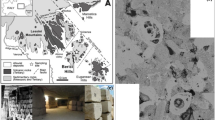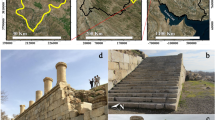Abstract
The general form of degradation of tuffeau is the progressive spalling of the surface of the stone. Over time, thick plates (1- to 3-cm thick) form gradually on the surface of the stone. Once the plate drops, the resulting stone surface turns into powder. At the Castle of Chambord, mineralogical analysis of the degraded stone, throughout its depth, shows the presence of gypsum (CaSO4·2H2O) located mainly within a crack network parallel to the surface. The objective of this research is to study different hypotheses of gypsum formation to improve the understanding of the damaging process of spalling. Fresh stones were subjected to artificial ageing in the laboratory through imbibition/drying tests, to study the resulting distribution of gypsum as a function of several parameters: the source of gypsum, initial stone cracking, drying conditions, and analysis after different measurement sequences. Tested samples were analysed at different stages of ageing by using X-ray diffraction and ion chromatography to localise and quantify the amount of gypsum throughout the depth. Results indicate that gaseous SO2 can lead to a distribution of gypsum very similar to that observed in stones subjected to spalling in situ at the Castle of Chambord.










Similar content being viewed by others
References
Ausset P, Crovisier JL, Del Monte M, Furlan V, Girardet F, Hammecker C, Jeannette D, Lefevre RA (1996) Experimental study of limestone and sandstone sulphation in polluted realistic conditions: the Lausanne Atmospheric Simulation Chamber (LASC). Atmos Environ 30(18):3197–3207
Bai Y, Thompson GE, Martinez-Ramirez S (2006) Effects of NO2 on oxidation mechanisms of atmospheric pollutant SO2 over Baumberger sandstone. Build Environ 41(4):486–491
Beck K, Al-Mukhtar M (2005) Multi-scale characterisation of two French limestones used in historic constructions. Int J Restor 11(4):219–226
Beck K, Al-Mukhtar M (2010) Weathering effects in an urban environment: a case study of a French porous limestone. Geol Soc Lond SP 331:103–111. doi:10.1144/SP331.8
Beck K, Al-Mukhtar M, Rozenbaum O, Rautureau M (2003) Characterisation, water transfer properties and deterioration in tuffeau: building material in the Loire valley-France. Int J Build Environ 38(9):1151–1162
Benavente D, Cultrone G, Gomez-Heras M (2008) The combined influence of mineralogical, hygric and thermal properties on the durability of porous building stones. Eur J Miner 20:673–685
Berthonneau J, Grauby O, Bromblet P, Vallet JM, Dessandier D, Baronnet A (2012) Role of swelling clay minerals in the spalling decay mechanism of the “pierre du midi” limestone (South-East of France). In: 12th international congress on the deterioration and conservation of stone, 22–26 October 2012, New York
Brimblecombe P, Grossi CM (2009) Millennium-long damage to building materials in London. Sci Total Environ 407(4):1354–1361
Brunet-Imbault B (1999) Etude des patines de pierres calcaires mises en œuvre en région centre. French Ph-D thesis, University of Orléans
Cautru JP (1976) Le Tuffeau de Touraine—Étude de son altération. French report, BRGM Orléans—76 SGN 012 MTX
Charola AE, Puhringer J, Steiger M (2007) Gypsum: a review of its role in the deterioration of building materials. Environ Geol 53:339–352
Colas E, Mertz JD, Thomachot-Schneider C, Barbin V, Rassineux F (2011) Influence of the clay coating properties on the dilation behavior of sandstones. Appl Clay Sci 52(3):245–252
Desbois, Father and Son (1894) Notice des travaux de restauration exécutés au château de 1882 à 1894. Paris
Gomez-Heras M, Smith BJ, Viles HA (2008) Laboratory modelling of gypsum crust growth on limestone related to soot pollution and gaseous sulphur: implications of ‘cleaner’ environments for stone decay. In: 11th international congress on deterioration and conservation of stone, Torun
Grossi CM, Murray M (1999) Characteristics of carbonate building stones that influence the dry deposition of acidic gases. Constr Build Mater 13(3):101–108
Grossi CM, Esbert RM, Díaz-Pache F, Alonso FJ (2003) Soiling of building stones in urban environments. Build Environ 38(1):147–159
Gutiérrez J, Mas A, Gil E, Galvañ V (2012) Clay-related damage in rainscreen walls built with natural stone coverings. Constr Build Mater 29:357–367
Hammecker C (1995) The importance of the petrophysical properties and external factors in the stone decay on monuments. Pure Appl Geophys PAGEOPH 145(2):337–361
Haneef SJ, Johnson JB, Jones M, Thompson GE, Wood GC, Azzaz SA (1993) A laboratory simulation of degradation of Leinster granite by dry and wet deposition processes. Corros Sci 34(3):511–524
Janvier-Badosa S (2012) Le carnet de santé d’un monument, application au château de Chambord. French Ph-D thesis, University of Orléans, p 305
Janvier-Badosa S, Beck K, Brunetaud X, Al-Mukhtar M (2013a) A historical study of Chambord castle: a basis for establishing the health record of the monument. Int J Archit Herit 7(3):247–260
Janvier-Badosa S, Beck K, Brunetaud X, Al-Mukhtar M (2013b) The occurrence of gypsum in the scaling of stones at the castle of Chambord (France). J Environ Earth Sci. doi:10.1007/s12665-013-2865-2
Janvier-Badosa S, Brunetaud X, Beck K, Al-Mukhtar M (2014) Kinetics of stone degradation of the Castle of Chambord-France, J Archit Herit. Accepted with minor revisions
Jeannette D (1992) Morphologie et nomenclature des altérations. La conservation de la pierre monumentale en France, ouvrage collectif sous la direction de Philippon J., Jeannette D., et R.A. Lefèvre, presses du CNRS, pp 51–72
Kloppmann W, Bromblet P, Vallet JM, Vergès-Belmin V, Rolland O, Guerrot C, Gosselin C (2011) Building materials as intrinsic sources of sulphate: a hidden face of salt weathering of historical monuments investigated through multi-isotope tracing (B, O, S). Sci Total Environ 409(9):1658–1669
Normal 13/83 (1983) Dosaggio dei sali solubili, CNR-ICR, Rome, Italy
Pauly JP (1990) Altération de la Pierre en œuvre en relation avec la climatologie et l’architecture. Simulation et produits de protection. French Ph-D thesis, Institute National Polytechnique de Loraine
Prick A (1996) Utilisation de la méthode dilatométrique dans l’étude expérimentale de l’altération de calcaires et de granites par du sulfate de calcium. In: Proceeding of the 1995 LCP congress, Montreux, pp 177–185
Rautureau M (2001) Tendre comme la pierre, ouvrage collectif sous la direction de Michel Rautureau. Ed. Conseil régional, Centre et Université d’Orléans
Rolland O (1999) Les châteaux de la Loire malades du plâtre? CoRé 6:49–53
Saiz-Jimenez C (1997) Biodeterioration vs. biodegradation: the role of microorganisms in the removal of pollutants deposited on historic buildings. Int Biodeterior Biodegrad 40(2–4):225–232
Sanjurjo Sánchez J, Romaní JRV, Alves C (2011) Deposition of particles on gypsum-rich coatings of historic buildings in urban and rural environments. Constr Build Mater 25(2):813–822
Török Á, Licha T, Simon K, Siegesmund S (2011) Urban and rural limestone weathering; the contribution of dust to black crust formation. Environ Earth Sci 63(4):675–693
Vallet JM, Gosselin C, Bromblet P, Rolland O, Vergès-Belmin V, Kloppmann W (2006) Origin of salts in stone monument degradation using sulphur and oxygen isotopes: first results of the Bourges cathedral (France). J Geochem Explor 88(1–3):358–362
Van T-T, Beck K, Al-Mukhtar M (2007) Accelerated weathering tests on two highly porous limestones. Environ Geol 52(2):283–292
Verges-Belmin V, Godin J, Brunjail C, Chéné G (2001) Etudes de cas, l’église Notre-Dame-la-Grande de Poitiers et la cathédrale Saint-Gatien de Tours, Géomécanique environnementale, risques naturels et patrimoine, sous la direction de Schrefler et Delage, éd. Hermès Science publication, pp 307–329
Warscheid T, Braams J (2000) Biodeterioration of stone: a review. Int Biodeterior Biodegrad 46:343–368
LIG’AIR (2007) Monitoring air quality in the Central Region, France. http://www.ligair.fr/
Author information
Authors and Affiliations
Corresponding authors
Rights and permissions
About this article
Cite this article
Janvier-Badosa, S., Beck, K., Brunetaud, X. et al. Gypsum and spalling decay mechanism of tuffeau limestone. Environ Earth Sci 74, 2209–2221 (2015). https://doi.org/10.1007/s12665-015-4212-2
Received:
Accepted:
Published:
Issue Date:
DOI: https://doi.org/10.1007/s12665-015-4212-2




